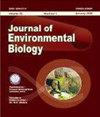Comparative studies on ber genotypes under arid conditions of Western Maharashtra
IF 0.7
Q4 ENVIRONMENTAL SCIENCES
引用次数: 0
Abstract
Aim: To determine the nature and magnitude of variation among ber genotypes for different morphological and biochemical characters; and to identify the potential genotypes with promising attributes under arid conditions of Western Maharashtra. Methodology: The observations on metric traits were recorded following the standard procedures. The genetic divergence among the 28 ber genotypes was estimated by Principal Component Analysis and Hierarchical Cluster Analysis (HCA). Results: The genotype S211 had performed better in terms of fruit weight and estimated the heaviest fruit (22.58 g). The maximum fruit length (4.3 cm) was determined in the genotype Mundia, while the genotype Seo had the maximum fruit diameter (3.60 cm). Genotypes Katha (6.8 kg), S211 (6.7 kg), Dandan (6.4 kg) and Betawadi (6.1 kg) were found superior for yield than the remaining genotypes. In terms of fruit quality, Senure No.3 contained maximum TSS content (21.70 ºBrix) whereas Mundia witnessed minimum titratable acidity (0.19%) and Safeda Rohtaki had the highest acidity percentage (0.87%). Interpretation: PCA revealed Nazuk, Bagwadi, Banarasi Pebandi, and Senure No.3 to be superior ber genotypes that outperformed PC1 and PC2 based on the quality of representation of these genotypes on the factor map. Key words: Arid zone, Ber genotypes, Genetic divergence, Ziziphus species马哈拉施特拉邦西部干旱条件下ber基因型的比较研究
目的:确定不同形态和生化特征的ber基因型之间的变异性质和幅度;并在马哈拉施特拉邦西部干旱条件下鉴定具有前景属性的潜在基因型。方法:按照标准程序记录对度量性状的观察结果。采用主成分分析和层次聚类分析方法对28个ber基因型间的遗传差异进行了估计。结果:S211基因型在果实重量方面表现较好,估计果实最重(22.58g)。Mundia基因型的最大果实长度(4.3厘米),而Seo基因型的果实直径最大(3.60厘米)。基因型Katha(6.8公斤)、S211(6.7公斤)、Dandan(6.4公斤)和Betawadi(6.1公斤)的产量高于其余基因型。就果实质量而言,Senure 3号含有最高的TSS含量(21.70ºBrix),而Mundia的可滴定酸度最低(0.19%),Safeda Rohtaki的酸度百分比最高(0.87%),和Senure 3号是优于PC1和PC2的ber基因型,基于这些基因型在因子图上的表现质量。关键词:干旱区,Ber基因型,遗传分化,酸枣属
本文章由计算机程序翻译,如有差异,请以英文原文为准。
求助全文
约1分钟内获得全文
求助全文
来源期刊

Journal of environmental biology
ENVIRONMENTAL SCIENCES-
CiteScore
1.70
自引率
0.00%
发文量
92
审稿时长
3 months
期刊介绍:
Information not localized
 求助内容:
求助内容: 应助结果提醒方式:
应助结果提醒方式:


